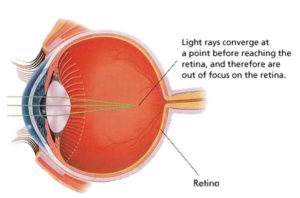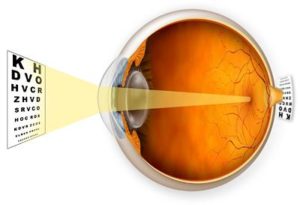Vision Facts
The following eye conditions are called refractive errors. While they do not represent a serious eye disorder, they can cause significant problems for patients. They can usually be corrected with eyeglasses, contact lenses, laser refractive surgery, or intraocular lens implant surgery.
Myopia (Nearsightedness)

A myopic eye is longer than normal or has a cornea that is too steep. As a result, light rays focus in front of the retina instead of on it. Close objects look clear but distant objects appear blurred.
Myopia is inherited and is often discovered in children when they are between ages 8 and 12 years old. During the teenage years, when the body grows rapidly, myopia may become worse. Between the ages of 20 and 40, there is usually little change.
Hyperopia (Farsightedness)
A hyperopic eye is shorter than normal or has a cornea that is too flat. As a result, light rays focus beyond the retina instead of on it. Most children are farsighted, yet they do not experience blurry vision. With focusing (accommodation), children’s eyes are able to bend the light rays and place them directly on the retina. As long as the farsightedness is not too severe, hyperopic children will have clear vision for seeing objects at a distance and up close.

As we get older we slowly lose our ability to focus, and adults with hyperopia may experience increased difficulties with reading or other tasks up close. And eventually adults with hyperopia will usually experience problems with their distance vision as well.
Astigmatism
The cornea is the clear front window of the eye. A normal cornea is round and smooth, like a basketball. If you have astigmatism, the cornea curves more in one direction than in the other, like a football.
Astigmatism distorts or blurs vision for both near and far objects. It’s almost like looking into a fun-house mirror in which you appear too tall, too wide, or too thin. It is possible to have astigmatism in combination with myopia or hyperopia.
Presbyopia (Aging Eyes)
When you are young, the lens in your eye is soft and flexible. The lens of the eye changes its shape easily, allowing you to focus on objects both close and far away. After the age of 40, the lens becomes more rigid. Because the lens can’t change shape as easily as it once did, it is more difficult to read at close range. This normal condition is called presbyopia.
You can also have presbyopia in combination with myopia, hyperopia, or astigmatism. Contact our office for more information.


